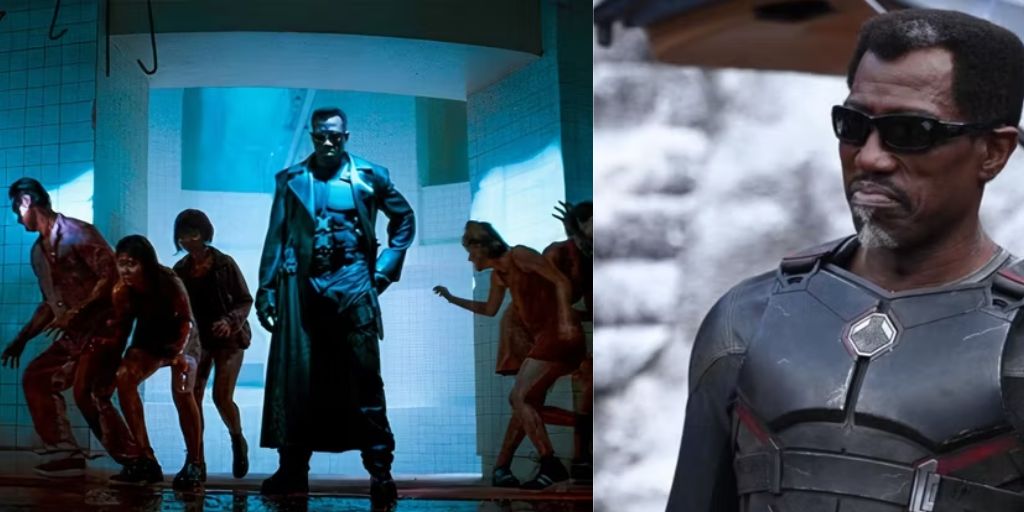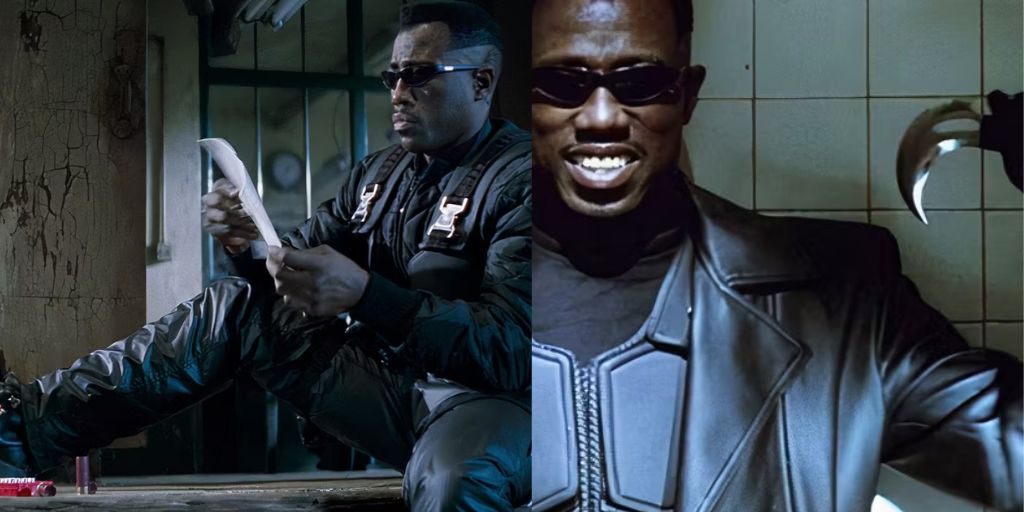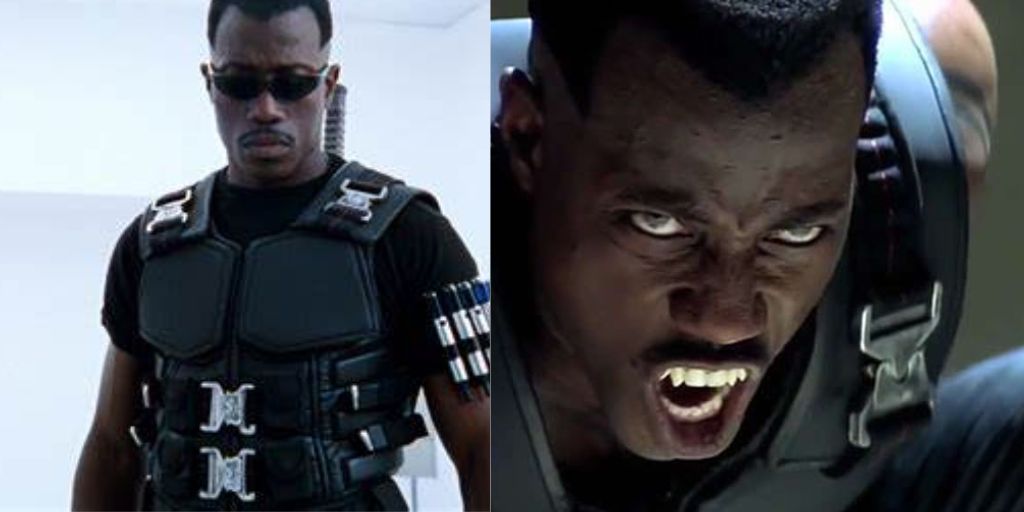Anyone who has watched the Blade movies knows the story of Wesley Snipes’ famous vampire hunter. Before Eric Brooks, the character’s real name, was born, his life took a drastic turn when the vampire Deacon Frost attacked his mother.
This attack passed on some of the traits of a vampire to Eric, without him inheriting the most significant vampire weakness – sensitivity to sunlight. Due to this unique trait, Blade was given the nickname “Daywalker” by vampires.
He dedicated his life to hunting and destroying vampires while also battling his inner urge to drink blood. This is a major update from Blade’s original character in Tomb of Dracula #10 created by Marv Wolfman and Gene Colan.
In that early version, Blade also survived Deacon Frost’s attack, but he remained fully human and was immune to being turned into a vampire by their bites.
However, after the release of the first Blade movie, his character evolved, and the change involved another well-known Marvel vampire: Michael Morbius, also known as Morbius the Living Vampire.
How Morbius Helped Blade Become a Daywalker
Blade’s transformation into the Daywalker we know today happened in Peter Parker: Spider-Man #7, written by Howard Mackie and illustrated by John Romita Jr. The story begins when Spider-Man encounters Hunger, a vampiric villain.
As the events unfold, it becomes clear that Blade is also hunting Hunger. Hunger had possession of a mysterious trunk, which soon attracted the attention of Wilson Fisk, also known as the Kingpin of Crime. Fisk’s criminal network had its eyes on this trunk for its secrets.
As Spider-Man and Blade joined forces to battle Fisk’s henchmen, Kingpin opened the mysterious trunk, revealing Morbius the Living Vampire inside. Morbius had been captured and was being transported to a secret location for further experimentation.
Spider-Man attempted to reason with Blade, arguing that Morbius wasn’t a full vampire and therefore shouldn’t be staked. Despite Spider-Man’s pleas, the situation escalated, and Morbius bit Blade during their confrontation.

At the time, Blade’s reaction to the bite wasn’t immediate or drastic, so its significance wasn’t clear right away. However, the impact of Morbius’ bite would eventually be revealed to have significant consequences for Blade’s powers and abilities.
The Effects of Morbius’ Bite on Blade’s Powers
The bite from Morbius had a lasting impact on Blade and made him far more dangerous to vampires. Due to the combination of Blade’s unique blood and Morbius’ altered genetics, Blade developed several new abilities that made him a formidable opponent.
These included superhuman strength, enhanced agility, and a healing factor that allowed him to recover quickly from injuries. Additionally, Blade gained the ability to sense supernatural creatures, which gave him an advantage when tracking and hunting vampires.
This combination of abilities made Blade not just a skilled vampire hunter, but also a being with the powers of a vampire, minus their weaknesses. He became a true Daywalker, able to operate during daylight hours without the vulnerabilities that traditional vampires suffer from.
Blade’s new powers put him on a level playing field with the very creatures he despised. This transformation allowed him to fight vampires on their own terms, without being hindered by their limitations.
Blade and Morbius would cross paths again in later comics, particularly in a series written by Marc Guggenheim and illustrated by Howard Chaykin. This encounter took place during the Civil War comic event, and by this time, Morbius had signed the Superhuman Registration Act.

This law required all superhumans to register their identities and follow government regulations. As a result, Morbius was legally authorized to arrest Blade, adding an interesting dynamic to their already complicated relationship.
Blade and Morbius Almost Fought on the Big Screen
While Blade and Morbius’ rivalry played out in the comics, the two characters almost faced off in the Blade films as well. Originally, there were plans for the two to clash on the big screen.
In fact, in a deleted scene from the first Blade movie, Morbius was supposed to make an appearance, hinting at a future confrontation between the two.
Director Stephen Norrington even portrayed Morbius in the scene, although he decided not to return for the second film, which was eventually directed by Guillermo del Toro. The plan to include Morbius was ultimately shelved, and the vampire didn’t appear in the Blade film series.
It wasn’t until 2022 that Morbius finally appeared in theaters, with Jared Leto taking on the role of the Living Vampire in the film Morbius.
Ironically, the comic storyline from Peter Parker: Spider-Man #7-8, in which Blade, Morbius, and Spider-Man all cross paths, became a source of inspiration for the Morbius film’s antagonist, Milo (played by Matt Smith). Milo’s transformation into a vampire closely resembled Hunger’s arc in the comic, and even Milo’s real name, Lucien, was suspiciously similar to Hunger’s real name, Loxias Crown.
Blade’s Transformation Into a Daywalker Shaped His Comic Legacy
The first Blade movie is often credited with launching a wave of successful comic book films. It proved that lesser-known characters could be just as interesting and engaging as mainstream heroes like Spider-Man or the X-Men.
The film’s success influenced the Marvel Cinematic Universe (MCU) and its approach to showing a wider variety of characters. This approach was later mirrored by DC Studios, led by James Gunn and Peter Safran.
But the Blade film’s impact didn’t stop at influencing the cinematic world. It also began a trend within the comics, where characters were adapted to align with their film counterparts. Before the movie, Blade was often depicted in the comics wearing a maroon coat, a bright green visor, and using wooden knives to fight vampires.

However, after the release of the film, Blade’s appearance was updated to match Wesley Snipes’ portrayal.
In Peter Parker: Spider-Man #7, Blade was shown wearing a long black trench coat, sunglasses, and wielding a katana – the look Snipes made iconic on the big screen. This transformation has continued to shape how Blade is portrayed in the comics to this day.
Blade’s transformation into the Daywalker was not only significant for his character development, but it also created a new level of depth. His hatred for vampires remained strong, but he could now battle them on equal footing because he had many of their abilities.
This change made Blade a more complex and compelling character. The fact that all of this happened due to a bite from a “living” vampire makes Blade’s story even more unique within the Marvel Universe.





